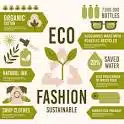
Brands dealing in sustainable fashion believe in creating fashionable clothes in a way that they keep humanity in consideration and minimise the impact on the environment in the best possible way. The aim of sustainable fashion is to work without impacting the environment in a negative manner.
If we go by the data, fashion industry is responsible for atleast 10% greenhouse gas emissions and almost 20% of the wastewater globally, and also consumes more energy than the shipping and aviation sectors together.
Fashion Effect on water-
Fashion, on a global basis uses 93 billion metric tonnes of water, which is a huge amount. The dyeing process used for cotton garments uses toxic chemicals which contribute to water pollution.
Effect on the climate-
Wood pulp is also required by the fashion industry for which millions of trees are cut down every year and deforestation has gone up tremendously.
Fashion industry produces carbon dioxide which results in greenhouse gas emissions and this happens in extremely huge quantities. Polyester is nothing but plastic made out of fossil fuels and comprises for almost 65% of all the clothing materials and oil consumption is almost 70 million barrels per year. A lot of plastic made from fossil fuels is also used for packaging and making hangers.
Increasing waste-
Recyling of clothes generally does not happen and less than 1 % of clothes get recycled every year. The fibre used in clothing is generally polymers, which are formed by long complex chained molecules. The discarded clothes after use go to landfills and therefore being polymer based, it does not disintegrate and it is also unfit for recycling as the fabric does not remain so strong after use. The polyester based clothes do not disintegrate and produce methane which amounts to greenhouse emission, whereas cotton based clothes disintegrate in a few months.
Microplastic pollution-
During the pandemic, people have lived in comfortable clothing made of breathable and stretchable fabric, which comes due to the usage of synthetic yarn, spandex or nylon, which is ultimately plastic. When such clothes are washed, microplastics from the fibers shed off into the water. Some of it is filtered out at wastewater treatment plants together with human waste and is used for agriculture. So the microplastics enter the soil and form a part of the food chain and some way into the rivers and oceans.
Therefore its all the more important to think about the sustainability factor required in the fashion industry.

Read more: Lakmé Fashion Week, Designer’s the Showstealer













